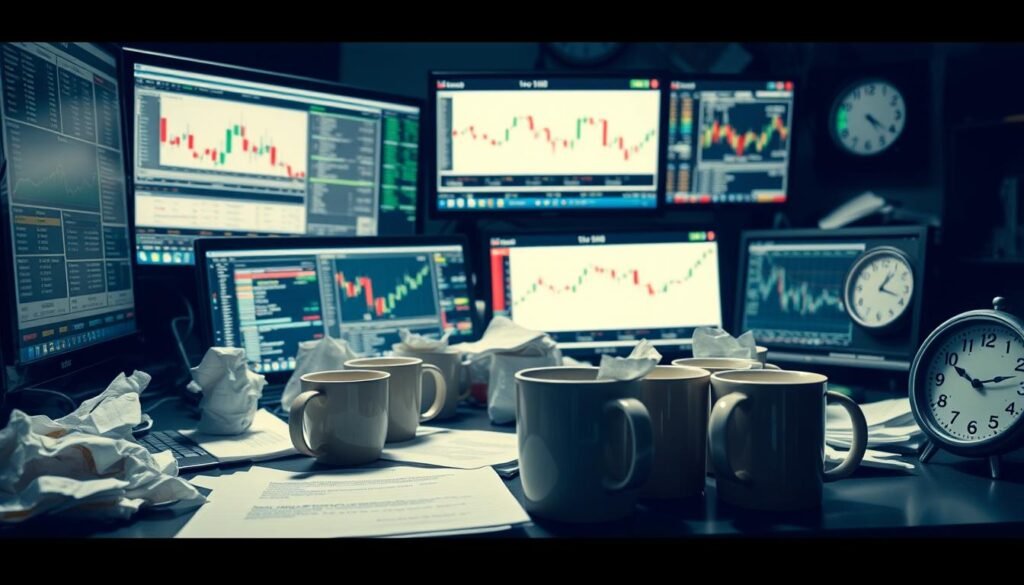The world of proprietary trading is full of chances and dangers. Even the best traders can make common mistakes in prop firm challenges. Knowing and avoiding these mistakes early can help you succeed in prop trading.
Many traders start with good plans and determination. But they fail because of prop trading errors they could have avoided.
This part talks about the big mistakes that can ruin a trader’s journey in proprietary firms. Knowing why traders fail is key. We’ll look at important skills like risk management, saving capital, and staying mentally strong. These are the basics of being a successful prop trader.
Understanding these mistakes is not just about being careful. It’s about taking steps to improve your trading path. Your goal to do well in prop trading starts with knowing these mistakes and how to avoid them.
Key Takeaways
- Identify the overlooked mistakes that many traders make in proprietary firm challenges.
- Understand the key elements of discipline and risk management required for prop trading success.
- Learn how emotional control and adequate capitalization play into avoiding common errors.
- Recognize the importance of consistently refining trade strategies and decision-making processes.
- Discover the foundation of psychological fortitude necessary to excel within the prop trading landscape.
Understanding Prop Firm Challenge Requirements
Starting a proprietary trading firm challenge means knowing the rules well. Prop firms have strict rules to keep their trading environment fair. Understanding these rules can help traders avoid big mistakes.
The Importance of Reading the Fine Print
Before joining a prop firm challenge, read the contract carefully. The fine print has key details like fees, payout rules, and trading limits. Missing or misunderstanding these can cause big problems and losses. Knowing these rules helps traders plan better and meet the firm’s standards.
Account Size and Leverage Considerations
Account size and leverage are very important in prop trading. Prop firms offer different account sizes with varying leverage levels. Higher leverage means bigger potential gains but also bigger risks. Choosing the right account size based on your risk level and strategy is key to avoiding mistakes.
Understanding the rules of a prop firm challenge is crucial. It helps traders avoid common mistakes and do well in competitive trading. Even small mistakes in following the rules can cause big problems.
Your Guide to Managing Risk in Prop Trading
Managing risk in prop trading is more than just avoiding losses. It’s about increasing your chances of making money. Success comes from setting achievable prop trading risk goals and using a solid stop loss strategy. Here’s how to match these with your trading methods.
Setting Realistic Risk Management Goals
It’s vital to set goals that protect your money over time. First, figure out how much risk you can handle and how much money you have. Then, match these with the risks of the markets you trade in. This way, your goals fit your unique situation, not just general rules.
Using Stop Losses Effectively
A stop loss strategy is key for any trader. It acts as a shield against sudden market changes. But stop losses do more than just prevent losses. They help you stay calm and make smart choices, even when things get tough.
| Risk Tolerance | Capital Allocation | Stop Loss Setting |
|---|---|---|
| Low Risk Profile | 5-10% per trade | 2-3% below purchase price |
| Medium Risk Profile | 10-15% per trade | 3-5% below purchase price |
| High Risk Profile | 15-20% per trade | 5-7% below purchase price |
The table shows how different risk levels match with capital and stop loss settings. By adjusting these based on your risk profile, you get a custom plan. This plan helps you control outcomes better. Using these strategies can make your prop trading stand out.
Why Emotional Discipline Matters in Prop Firm Challenges
Managing emotions well is key in prop trading’s high-pressure world. Emotional discipline helps avoid risks and keeps decisions steady during market ups and downs. Controlling emotions in trading can make all the difference between success and failure.
Letting emotions control can lead to quick and big mistakes. Fear, greed, or excitement can cause impulsive decisions that harm trades. So, it’s vital to have ways to control emotions.
Here are some techniques that show why emotional control is crucial:
- Mindfulness and meditation to improve focus and calm.
- Regular reviews of trades to check decisions and results.
- Clear rules for trading to avoid confusion and emotional choices.
Effective emotional control is not about suppressing your emotions but rather managing your reaction to market events in a way that is consistent with your trading strategy.
| Strategy | Effect on Emotional Control | Impact on Trading Outcome |
|---|---|---|
| Predefined Entry and Exit Rules | Reduces panic and hasty decisions | Increases consistency in winning trades |
| Continuous Education | Builds confidence and reduces fear | Helps in adapting to market changes effectively |
| Risk Management Limits | Controls fear of loss | Prevents significant financial blowbacks |
Learning emotional discipline in prop trading is more than just avoiding emotional trading. It’s a strategy to improve trading performance. As traders get better at controlling emotions, they face fewer failures and gain an edge in the fast-paced world of proprietary trading.
Common Pitfalls: Overtrading in Prop Firms
Challenges in proprietary trading often come from overtrading mistakes. This can hurt a trader’s success a lot. It’s key to know why it happens and to stick to strict trading discipline.
One big reason for overtrading is the urge to make money from every chance. This can make traders tired and less sharp. To fight this, traders need a solid plan that values quality over just doing a lot.
To learn more about prop firm rules and how to trade better, check out current prop firm strategies. See how they affect how well traders do.

| Issue | Impact | Prevention Strategy |
|---|---|---|
| Frequent Trading | Dilutes focus and increases fees | Set trade limits per day |
| Minimal Gains | Small profits overshadowed by costs | Focus on higher quality setups |
| Poor Risk Management | Potential significant losses | Adhere to risk-reward parameters |
The main way to handle challenges in proprietary trading and cut down overtrading mistakes is with strong trading discipline. Finding the right mix of action and thought helps keep profits coming in tough markets.
Strategies for Avoiding Undercapitalization
One big challenge in proprietary trading is undercapitalization in prop trading. Knowing how to handle this can really help traders stay in the game and make money. We’ll look at smart capital allocation in trading and learn more about margin requirements knowledge. These are key to doing well and avoiding big financial losses.
Capital Allocation Techniques
Managing money well is crucial in proprietary trading. It’s about spreading out capital across different trades. This balances risk and potential gains. Here are some important strategies:
- Risk Assessment: Put more capital into trades with lower risk. This helps protect against big losses.
- Diversification: Spread investments across different markets and instruments. This reduces the impact of any one bad investment.
- Performance Review: Check how your strategies are doing regularly. Adjust your capital allocation based on what’s working.
Understanding Margin Requirements
Margin trading can increase both profits and losses. Knowing about margin requirements knowledge is key to managing these risks. Margin requirements are the amount of money needed in your account to start a trade. Here are important things to remember:
- Minimum Margin: Know the minimum margin your brokerage requires. This is the smallest amount needed to start a trade.
- Maintenance Margin: You also need to keep extra capital in your account to keep trades open. Not having enough can lead to a margin call.
- Margin Call Strategy: Have a plan for when you get a margin call. This might include setting aside more money or closing trades to manage risk.
| Factor | Importance in Prop Trading | Impact on Capitalization |
|---|---|---|
| Risk Assessment | High | Directs capital allocation to optimize trade outcomes |
| Diversification | Medium | Mitigates risks associated with underperformance in single assets |
| Maintenance Margin | Essential | Mainstay for continuing trading operations without interruptions |
Common Mistakes That Lead to Prop Firm Challenge Failures
It’s key to avoiding prop trading mistakes for those in a proprietary trading firm’s challenge. We’ll cover some common errors that can cause prop trading failures. Each mistake is explained clearly, along with tips on how to avoid it.
- Insufficient Research and Preparation: Many traders dive into challenges without being ready. They miss out on learning from prop firm training mistakes that are common in the field.
- Poor Risk Management: Not setting tight risk limits can lead to big financial losses.
- Lack of a Solid Trading Plan: Trading without a clear strategy is like sailing without a compass. It often results in unpredictable trading and a lack of consistency.
- Emotional Trading Decisions: Allowing emotions to guide trading can pull a trader away from logical, well-thought-out strategies.
| Mistake | Consequences | Preventative Measures |
|---|---|---|
| Ignoring Volatility | Unexpected market shifts leading to heavy losses | Use tools like volatility indicators to adjust strategies promptly. |
| Overleveraging | Amplifies losses beyond manageable levels | Adhere strictly to leverage rules set by the prop firm. |
| Failing to Follow Firm’s Rules | Possible disqualification from the trading challenge | Regularly review the firm’s guidelines to ensure compliance. |
| Not Using Stop Losses | Significant account drawdowns | Implement stop losses to protect against market downturns. |
In the competitive world of proprietary trading, knowing and avoiding prop trading mistakes is crucial for success. By learning from prop trading failures, traders can better prepare for the challenges of prop trading.
Navigating News Events During Prop Trading Challenges
In the fast-paced world of prop trading, keeping up with news is key. News can cause big market swings. So, mastering news trading and watching an economic calendar is vital for traders in proprietary firms.
Developing a News Trading Strategy
Creating a good news trading strategy starts with knowing which news affects the markets you trade. Big news, like economic reports or central bank decisions, can lead to big swings. Traders need to know the past data and how markets react to predict better.
To optimize a news trading strategy, traders should:
- Look at how markets reacted to similar news in the past.
- Plan when to enter and exit trades to avoid making rash decisions during big swings.
- Use trading tech for real-time data and alerts to stay on top of market changes.
Keeping Up with Economic Calendars
Using an economic calendar is a must for successful news trading. Economic calendars list events that can affect different assets. By watching these calendars, traders can get ready for big swings and plan their strategies.
Effective use of an economic calendar for trading includes:
- Keep up with which events are coming and how they might affect markets.
- Set alerts for big economic news.
- Change trading plans based on expected news to take advantage of chances or protect against losses.
By using prop trading news, strategies, and calendars every day, you can improve your trading skills during challenges.
The Role of Consistency in Proprietary Trading Success
To achieve lasting proprietary trading success, sticking to a consistent trading strategy is key. This steady approach creates a reliable investment environment. It also boosts trading firm stability. By staying disciplined and avoiding sudden changes, traders can see steady profits and manage risks well.

In a world where markets are always changing, a strict trading plan is crucial. It lets strategies show their worth over time, making the trading firm stronger. A routine that focuses on consistency helps deal with the ups and downs of the market.
| Aspect | Importance |
|---|---|
| Consistent Analysis | Helps traders avoid quick decisions and stick to their plans. |
| Routine Review | Allows for finding and fixing strategy issues, leading to better results. |
| Stress Management | Is vital for keeping a balanced mindset while trading, essential for long-term success. |
So, focusing on a consistent trading strategy and making regular checks and tweaks is the foundation for lasting proprietary trading success and trading firm stability. These steps help firms not just survive but flourish in the competitive world of finance.
Prop Trading Errors: The Pitfalls of Poor Strategy Adaptation
In the world of prop trading, sticking to one strategy too much can be a big mistake. It’s key for traders to know how important strategy adaptation in prop trading is. This helps them move through different market phases well.
Recognizing Market Phase Changes
Market phase recognition is a vital skill. It lets traders change their strategies based on the market’s current state. Each phase, like trending, consolidation, and breakout, needs a different approach for the best results.
Flexibility in Trading Approach
Creating flexible trading plans is crucial. It helps traders adjust fast to market changes, cutting losses and grabbing chances. Being flexible lets traders switch between playing it safe and being bold as the market demands.
| Market Phase | Strategy Adaptation Required |
|---|---|
| Trending | Use trend-following systems; increase position sizes. |
| Consolidation | Shorten trade duration; focus on range trading. |
| Breakout | Leverage breakout strategies; manage risk aggressively. |
Successful prop traders always work on improving their methods. They keep an eye out for signs that the market is changing. By adapting their strategies, they stay in sync with the market and improve their trading results.
Challenges in Proprietary Trading: Platform and Tool Misuse
Choosing the right trading platform and using proprietary trading tools are key in proprietary trading. But, using these tools wrong can hurt a trader’s performance.
Choosing the Right Trading Platform
The right trading platform makes trading better, with features that match your strategies. Look for reliability, easy use, and good analytical tools. Choose platforms with lots of educational resources and quick customer support to avoid misuse.
Utilizing Prop Firm Offered Tools
Proprietary trading tools can give you an advantage, but only if used right. Many traders struggle to understand these tools, leading to big mistakes. It’s crucial to get full training on each tool to use them well in your trading.
To help traders make good choices about platforms and tools, consider these tips:
- Compare different platforms to see which fits your trading style best.
- Try demos or trials to see how platforms work in real market conditions.
- Join forums or networks to learn from other traders about tool effectiveness.
- Keep learning and updating your skills to avoid misuse as the market changes.
By thinking about these points, traders can avoid the dangers of misuse. This can lead to better success in proprietary trading.
Mastering the Psychological Aspects of Trading Firm Challenges
Proprietary trading is not just about money. It also needs a strong grip on the psychological challenges traders face. This part talks about the key points to understand and beat the psychological barriers that can stop traders from doing well. We’ll look at loss aversion and the dangers of overconfidence.
Dealing with Loss Aversion
Loss aversion is a big psychological obstacle in trading. It makes traders hold onto losing trades, hoping to avoid more losses. But this can make things worse, leading to bigger losses and stress. It’s important for traders to know how to deal with loss aversion to improve their game.
Overcoming Overconfidence
Overconfidence can be a problem when traders think they can predict the market too well. This can lead to risky trading that doesn’t match the market. Traders need to keep a realistic view of their abilities and the market to avoid overconfidence’s pitfalls.
| Psychological Barrier | Common Symptoms | Strategies for Overcoming |
|---|---|---|
| Loss Aversion | Hesitance to close losing positions, emotional distress | Pre-defined loss limits, regular review of trade rationale |
| Overconfidence | Excessive risk-taking, neglect of risk management principles | Continuous learning, adherence to a well-tested trading plan |
By tackling these psychological challenges head-on, traders can stay calm and make smart choices, even when the market is shaky. This approach not only helps avoid big losses but also lets traders seize opportunities with a clear mind.
Importance of Timely Decision Making in Prop Firms
In the world of proprietary trading, decision making in trading is key. It’s what separates profit from loss. Making timely trading decisions is crucial for prop firm success factors. This part will cover strategies to improve decision-making, vital for using market chances and avoiding risks.
Traders need to quickly assess situations and act fast. Here are ways to get better at making quick trading decisions:
- Continuous practice with simulation tools to sharpen reaction times.
- Staying updated with real-time global financial news to anticipate market shifts.
- Using advanced analytics and trading algorithms that can suggest probable profitable trades.
The success of decision making in trading depends on quick analysis, predictive tech, and market knowledge. These help traders make timely trading decisions that benefit the prop firm’s goals.
Prop firm success factors depend on a team that can make fast, right decisions. These moments can make a firm stand out. Focusing on these skills is essential for any trading company aiming to succeed.
Prop Firm Training Mistakes: Neglecting Continuous Education
The financial markets change fast, needing a constant learning effort. Those who don’t keep up with new trading methods and rules often fall behind. This shows how prop firm training importance is key.
Investing in Ongoing Training
For traders in prop firms, learning never stops. It’s not just about getting better at trading. It’s also about growing and adapting. The importance of continuous education in trading shows in better results and fewer mistakes.
Learning from Past Trades
Learning from trading mistakes is vital for any trader. Good traders look back at their trades to see what they can do better. This helps them make smarter choices in the future.
| Aspect of Training | Benefits |
|---|---|
| Regular Market Analysis | Keeps traders informed of market trends and disruptions. |
| Advanced Trading Techniques | Enhances trading strategy complexity and effectiveness. |
| Post-Trade Review Sessions | Facilitates learning from mistakes and refining strategies. |
| Behavioral Psychology | Improves emotional discipline and decision-making under pressure. |
How to Bounce Back from Prop Trading Hiccups
Recovering from setbacks in proprietary trading is key. It’s not just about fixing mistakes but learning from them. Prop trading hiccups can hurt your confidence and balance, but they also offer a chance to grow and improve.
To bounce back, start by analyzing what went wrong. Was it a lack of discipline, an unexpected market event, or a failed strategy? Find clear solutions for each problem. Focus on managing risks and setting realistic goals. This helps avoid future mistakes and builds a mindset that sees challenges as opportunities for growth.
Keeping a positive mindset is crucial when facing trading challenges. It means not letting losses get you down but instead focusing on what you can do next. Building a strong routine, getting advice from experienced traders, and staying committed to learning are important steps. This approach turns obstacles into stepping stones on the path to success in trading.












